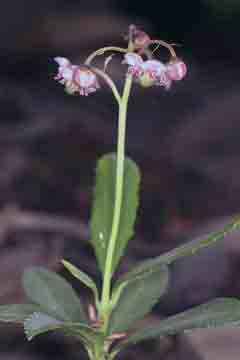 |
Pipsissewa, Chimaphila umbellata
(L.) W. P. C. Barton (left). The pipsissewa, or
prince’s pine, is a shade-loving, evergreen plant that bears attractive
parasol-shaped, five-petaled pink flowers. As with our other wintergreens,
it grows in cool forest surroundings. The species name Chimaphila,
means “winter-lover” derived from its evergreen properties. This
and other wintergreens have long been used medicinally both topically and
in beverages, probably without any real therapeutic benefit. A related plant,
the little prince’s pine (Chimaphila menziesii [R. Br. ex D.
Don] Spreng., not shown) occurs in the mountains of central and northern
Idaho. It has few flowers and its leaves are broadest near the base of the
blade.
Pink wintergreen, Pyrola asarifolia
Michx. (right). This generic name Pyrola
was derived from a Latin pyrus, for “pear” because of similar
shaped leaves in some species of wintergreen. The name asarifolia suggests
that the leaves resemble those of the wild ginger (Asarum caudatum).
The pink wintergreen is a reclusive plant, often found at higher elevations.
Nodding pink flowers form a loose cluster atop a bare stem. Each has five
dainty pink petals, ten stamens and a single protruding style.
|
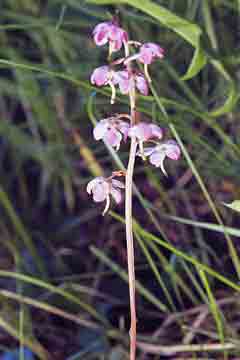 |
 |
Green wintergreen, Pyrola
chlorantha
Sw. (left). As both common and scientific
names suggest, the green wintergreen has light-green petals (chlorantha,
from the Greek, means “green flower”) as well as the protruding
style, common to the genus. It grows in partial shade, often in conifer forests.
As with other wintergreens, it blooms in mid-summer.
White-vein wintergreen, Pyrola picta
Sm. (right). While this plant’s flowers are similar
to those of our other pyrolas, its prominently patterned basal leaves make
it stand out in the shaded forests where it grows. Most of the plants in
the wintergreen family grow all across North America, but this plant is found
only in the West and in the Black Hills of South Dakota. |
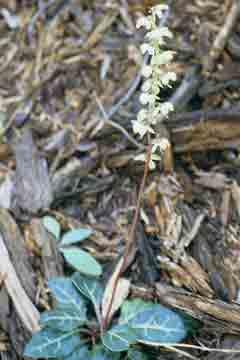 |
 |
Sidebells wintergreen, Orthilia
secunda (L.) House (left). This
little plant, while similar to the pyrolas, has somewhat different flowers.
It is easily identified because its greenish white flowers grow on only one
side of the stem (secunda, from the Latin, means “turned,”
or, in this context, “one sided”). It is a common plant and will
be found blooming in the open shade of evergreen forests in mid- to late
summer. As the name “wintergreen” implies, all of these plants
are evergreen.
|
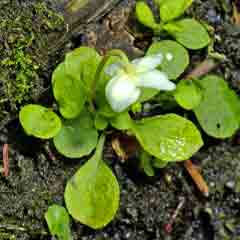 |
One-flower wintergreen, Moneses uniflora
(L.) A. Gray (left, right). The one-flower wintergreen
(also single-delight, wood nymph, shy-maiden, and wax-flower) is a widely
distributed plant that grows in moist places as high as the subalpine zone.
It is foundin all of our northern states, in the Rocky Mountain states,
throughout Canada, and Eurasia. It With its single (uniflora), five
petaled, nodding white flower and rosette of basal leaves it is easy to identify.
It is the only species in its genus. The name Moneses was derived from two
Greek words, monos and hesis, meaning “single
delight.” |
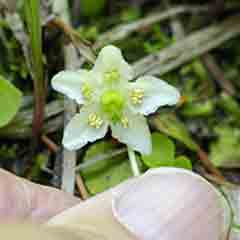 |
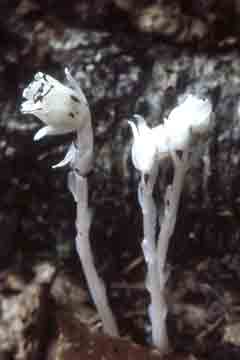 |
Indian pipe, Monotropa uniflora L.
The Indian pipe (left) occurs in Idaho, although
it less common than the pinesap shown on the right. The two plants shown
on this page are both saprophytes that thrive on forest litter. Plants in
this genus lack chlorophyll and their root systems are always associated
with minute fungi. The generic name Monotropa was derived from the
Greek words, mono for “one” and tropos for
“direction,” referring to other plants in genus Monotropa that
bear their flowers on one side of the stem.
Pinesap, Monotropa hypopithys
L. (left). The pinesap is also found in most of the United
States and in Eurasia. It is easily distinguished from the Indian pipe by
its yellow color, turning brown as it matures. Several small flowers are
clustered at the top of the stem, compared to the Indian pipe’s single
flower. The species name hypopithys was also derived from two Greek words,
hypo for “under” and pithys for “pine,” alluding to the
pine forests in which the plants are usually found. Identification is usually
not be a problem, although this plant and species of Corallorhiza
in the orchid family are rather similar in appearance;d both are saprophytes
that grow on shaded leaf-litter. |
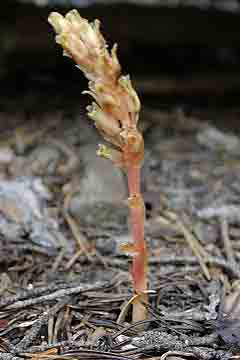 |








